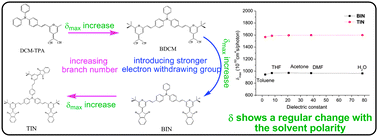Theoretical study of solvent effect on one- and two-photon absorption properties of starburst DCM derivatives
Abstract
The equilibrium geometries, electronic structures, one-

* Corresponding authors
a
State Key Laboratory of Theoretical and Computational Chemistry, Institute of Theoretical Chemistry, Jilin University, Changchun, People’s Republic of China
E-mail:
aimin_ren@yahoo.com
Fax: +86 (0)431 88498026
Tel: +86 (0)431 88499856
b
College of Chemistry, Jilin University, Changchun, People’s Republic of China
E-mail:
Jikangf@yahoo.com
Fax: +86 (0)431 88498026
Tel: +86 (0)431 88499856
c Department of Chemistry, University of North Texas, United States of America
d Department of Chemistry, Renmin University of China, Beijing People’s Republic of China
The equilibrium geometries, electronic structures, one-

 Please wait while we load your content...
Something went wrong. Try again?
Please wait while we load your content...
Something went wrong. Try again?
Y. Zhao, A. Ren, J. Feng, X. Zhou, X. Ai and W. Su, Phys. Chem. Chem. Phys., 2009, 11, 11538 DOI: 10.1039/B908415K
To request permission to reproduce material from this article, please go to the Copyright Clearance Center request page.
If you are an author contributing to an RSC publication, you do not need to request permission provided correct acknowledgement is given.
If you are the author of this article, you do not need to request permission to reproduce figures and diagrams provided correct acknowledgement is given. If you want to reproduce the whole article in a third-party publication (excluding your thesis/dissertation for which permission is not required) please go to the Copyright Clearance Center request page.
Read more about how to correctly acknowledge RSC content.
 Fetching data from CrossRef.
Fetching data from CrossRef.
This may take some time to load.
Loading related content
